#Hogg Hummock
Explore tagged Tumblr posts
Text
Black Residents Of Gullah-Geechee Enclave In Georgia Angered After Zoning Changes Pose Threat To Their Community
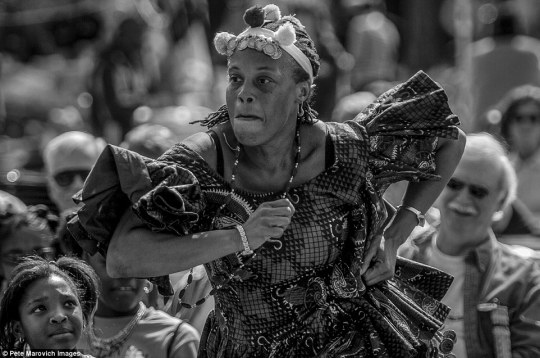
This small enclave is home to a majority of Black residents who are members of the Hogg Hummock community, which is also sometimes referred to as Hog Hammock. According to The Cultural Landscape Foundation, “Hog Hammock was one of fifteen African American Saltwater Geechee settlements on Sapelo Island, Georgia.
The Geechee are descendants of enslaved West Africans brought to work on Sea Island plantations along the Atlantic coast.” Sapelo island is located approximately 60 miles south of Savannah, Georgia and is only reachable by boat.
Almost three decades ago, the county adopted the zoning restrictions, “with the stated intent to help Hogg Hummock’s 30 to 50 residents hold on to their land,” the Associated Press reports.
But the McIntosh County’s elected commissioners recently voted 3-2 vote to change the restrictions. Now, Black residents fear that wealthy buyers will be prioritized over them, which could lead to increases in taxes.
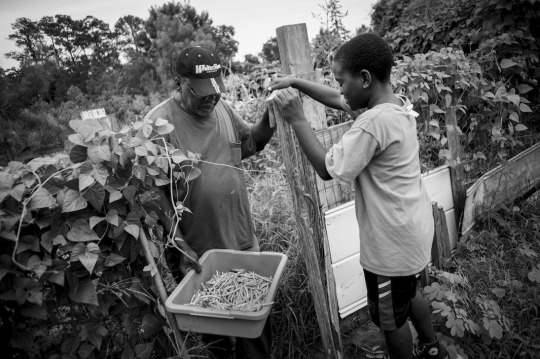
Residents also anticipate this could cause them to be pressured to sell their land, most of which has been in their family for generations. Atlanta resident Yolanda Grovner originally had a plan where she would ultimately retire on her island native father’s land that he owns in Hogg Hummock, but now she worries this might not be able to happen. Yolanda’s father George Grovner attended the meeting wearing a sticker, which read “Keep Sapelo Geechee,” in defiance of these planned zoning changes.

“It’s going to be very, very difficult,” said Yolanda, continuing, “I think this is their way of pushing residents off the island.”
In recent years, the population on Hogg Hummock has been shrinking because some families have sold their land to outsiders. David Stevens, Chairman of the Commission, said he’s been a visitor on Sapelo Island since the 1980s, and places the blame for these changes on those who are selling their land.
This could be partly true, as the vote followed new construction builds. The commissioners ruling “raised the maximum size of a home in Hogg Hummock to 3,000 square feet (278 square meters) of total enclosed space. The previous limit was 1,400 square feet (130 square meters) of heated and air-conditioned space,” per the Associated Press.
Stevens stated, “I don’t need anybody to lecture me on the culture of Sapelo Island.” “If you don’t want these outsiders, if you don’t want these new homes being built...don’t sell your land,” Stevens concluded.
But the remaining residents have vowed to keep fighting these ordinance changes, and it’s not a new phenomenon for them to fight with the local government either. In 2012, dozens of residents and landowners were able to successfully appeal property tax increases.
In addition, many have spent years “fighting the county in federal court for basic services such as firefighting equipment and trash collection before county officials settled last year,” writes the Associated Press.
Maurice Bailey is a native of Hogg Hummock whose mother Cornelia Bailey had deep roots to the island. Bailey was a Sapelo Island celebrity, keeping the community’s voice alive with her storytelling before she died in 2017. Maurice said, “We’re still fighting all the time,” adding, “They’re not going to stop. The people moving in don’t respect us as people. They love our food, they love our culture. But they don’t love us.”
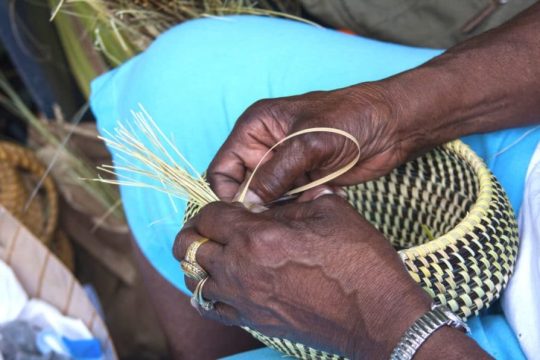
Some legal experts have hinted at due process violations as well as concerns about encroachment under the equal protection clause.
This issue becomes more complicated given the racial demographics of the county. Hogg Hummock is on the National Register of Historic Places, and in order for the Gullah-Geechee community to receive protections “to preserve the community, residents depend on the local government in McIntosh County, where 65% of the 11,100 residents are white,” says the Associated Press.
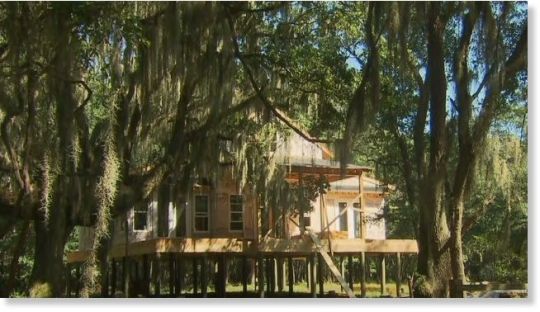
#Black Residents Of Gullah-Geechee Enclave In Georgia Angered After Zoning Changes Pose Threat To Their Community#sapelo#georgia sea islands#Gullah Geechee#Lowlands#Hogg Hummock#Sapelo Island#Gullah Geechee community
33 notes
·
View notes
Text
Absolutely shattered by the tragedy on Sapelo Island, GA yesterday.
It's a very small community of Gullah Geechee people and the ferry gangway collapsed at the end of a day of cultural celebration.
At least seven people are dead. More are missing or in critical condition.
I don't know of alternative links for aid at this time, but I know the Sapelo Island Cultural and Revitalization Society has a donation link for their organization at the bottom of the page and can use all of the help they can get.
The community of Hogg Hummock itself is mostly compromised of older residents on fixed incomes, so any assistance to help them get through this tragedy would be a big help.
#gullah geechee#Sapelo island#black culture#cw death#fundraiser#I don't know what to tag this for attention so please please share#I'd include SOLO as another route for donations but afaik that's only run by one guy and I can't find any word if he's okay#I am not Gullah Geechee and I do not live on Sapelo but this community has my full support and love#The linked organization is run by Gullah Geechee people directly
4 notes
·
View notes
Text
SICARS Multipurpose Center, Georgia
SICARS Multipurpose Center, Georgia
Hog Hammock, McIntosh County The Sapelo Island Cultural and Revitalization Society (SICARS) Multipurpose Center is located in Hog Hammock on Sapelo Island. From their website, the mission is “to preserve and revitalize the Hogg Hummock Community which is located on Sapelo Island, Georgia.” The organization was in 1993 by descendants to educate and preserve the history of Sapelo Island. They host…

View On WordPress
#Black history#Georgia#Hog Hammock#McIntosh County#National Register of Historic Places#Sapelo Island
0 notes
Text
St Lucie Connections - Lost Through Time
St Lucie Connections – Lost Through Time
Excerpt from 1839 Map of the Seat of War in Florida compiled by order of Brid. Gen. Z. Taylor principally from the surveys and reconnaissances of the Officers of the U.S. Army.
The following of which you will recognize many names and places, was shared from my mother, Sandra Henderson Thurlow. For years it lie dormant in her history files.
Written in 1881 as an article in an old time newspaper,
View On WordPress
#1881#1881 The Florida Star#and abound in black bass.#and Eleven Mile Creeks#“Indian River” by Elias B. Wager#“Old Cuban’s Place#called Five#earth works#Fords#Fort Pierce#Ft. Capron#having its origin in the Everglades#Herman’s Grove#hummock#Indian River Inlet to the Narrows#It has two branches from the Westward which have their sources in the “Big Cypress.” and are called Big and Little Cane Creeks#J. S. Fowler#Mount Elizabeth#Mr. Alex. Bell#Mr. Hogg#Mr. T. E. Richards#North Branch separates into three streams#Sandra Henderson Thurlow#Seminole war#spring of water#St Lucie Connections - Lost Through Time#St Lucie North and South Branch#Taylor Creek#Ten#The South Branch comes from away down to the Westward of Jupiter Lighthouse
0 notes
Text
Ga. islanders vow to keep fighting change favoring rich buyers

DARIEN, Ga. - Descendants of enslaved people living on a Georgia island vowed to keep fighting after county commissioners voted to double the maximum size of homes allowed in their tiny enclave.
Residents fear the move will accelerate the decline of one of the South’s few surviving Gullah-Geechee communities.
An aspect of the ordinance that residents take issue with is the fact that it erases a clause about protecting the island’s indigenous history.
During public meetings leading up to the vote, the zoning board proposed changes to the ordinance of lowering the newly allowed home size and removing talk of golf courses being added to the island.
Black residents of the Hogg Hummock community on Sapelo Island and their supporters packed a meeting of McIntosh County’s elected commissioners to oppose zoning changes that residents say favor wealthy buyers and will lead to tax increases that could pressure them to sell their land.
ISLAND’S HERITAGE
Gullah-Geechee communities like Hogg Hummock are scattered along the Southeast coast from North Carolina to Florida, where they have endured since their enslaved ancestors were freed by the Civil War. Scholars say these people long separated from the mainland retained much of their African heritage, from their unique dialect to skills and crafts such as cast-net fishing and weaving baskets.
Regardless, commissioners voted 3-2 to weaken zoning restrictions the county adopted nearly three decades ago with the stated intent to help Hogg Hummock’s 30 to 50 residents hold on to their land.
Yolanda Grovner, 54, of Atlanta said she has long planned to retire on land her father, an island native, owns in Hogg Hummock. She left the county courthouse Tuesday night wondering if that will ever happen.
“It’s going to be very, very difficult,” Grovner said. She added: “I think this is their way of pushing residents off the island.”
Hogg Hummock is one of just a few surviving communities in the South of people known as Gullah, or Geechee, in Georgia, whose ancestors worked island slave plantations.
MORE | Mom in Grovetown calls cops on U.S. energy secretary’s staff
Fights with the local government are nothing new to residents and landowners. Dozens successfully appealed staggering property tax hikes in 2012, and residents spent years fighting the county in federal court for basic services such as firefighting equipment and trash collection before county officials settled last year.
“We’re still fighting all the time,” said Maurice Bailey, a Hogg Hummock native whose mother, Cornelia Bailey, was a celebrated storyteller and one of Sapelo Island’s most prominent voices before her death in 2017. “They’re not going to stop. The people moving in don’t respect us as people. They love our food, they love our culture. But they don’t love us.”
Merden Hall, who asked not to be on camera, has lived on Sapelo his whole life. He says he’s worried about the sizes of homes now allowed on the island.
“I’m not comfortable with this. They approved the 3,000 square feet, that’s the only thing I disapprove of, because that’s going to raise property taxes,” he said.
Hogg Hummock’s population has been shrinking in recent decades, and some families have sold their land to outsiders who built vacation homes. New construction has caused tension over how large those homes can be.
Commissioners on Tuesday raised the maximum size of a home in Hogg Hummock to 3,000 square feet of total enclosed space. The previous limit was 1,400 square feet of heated and air-conditioned space.
Commissioner Davis Poole, who supported loosening the size restriction, said it would allow “a modest home enabling a whole family to stay under one roof.”
“The commissioners are not out to destroy the Gullah-Geechee culture or erase the history of Sapelo,” Poole said. “We’re not out to make more money for the county.”
Commission Chairman David Stevens, who said he’s been visiting Sapelo Island since the 1980s, blamed Hogg Hummock’s changing landscape on native owners who sold their land.
“I don’t need anybody to lecture me on the culture of Sapelo Island,” Stevens said, adding: “If you don’t want these outsiders, if you don’t want these new homes being built ... don’t sell your land.”
County officials have argued that size restrictions based on heated and cooled spaced proved impossible to enforce. County attorney Adam Poppell said more than a dozen homes in Hogg Hummock appeared to violate the limits, and in some cases homeowners refused to open their doors to inspectors.
Hogg Hummock landowner Richard Banks equated that to the county letting lawbreakers make the rules.
“If everybody wants to exceed the speed limit, should we increase the speed limits for all the speeders?” Banks said.
Hogg Hummock residents said they were blindsided when the county unveiled its proposed zoning changes on Aug. 16. Commissioners in July had approved sweeping zoning changes throughout McIntosh County, but had left Hogg Hummock alone.
Commissioner Roger Lotson, the only Black member of the county commission, voted against the changes and warned his colleagues that he fears they will end up back in court for rushing them.
Two attorneys from the Southern Poverty Law Center sat in the front row. Attorney Anjana Joshi said they had “due process and equal protection concerns” about the way the zoning ordinance was amended.
“In our view, this was not done correctly,” said Joshi, who added: “We’re just getting started.”
Located about 60 miles south of Savannah, Sapelo Island remains separated from the mainland and reachable only by boat. Since 1976, the state of Georgia has owned most of its 30 square miles of largely unspoiled wilderness. Hogg Hummock, also known as Hog Hammock, sits on less than a square mile.
Hogg Hummock earned a place in 1996 on the National Register of Historic Places, the official list of the United States’ treasured historic sites. But for protections to preserve the community, residents depend on the local government in McIntosh County, where 65% of the 11,100 residents are white.
#Ga. islanders vow to keep fighting change favoring rich buyers#Gullah Geechee#Gullah Land#sapelo#sapelo island#Freedmen Lands#Stolen Lands#nrohp#national register of historic places
66 notes
·
View notes
Text
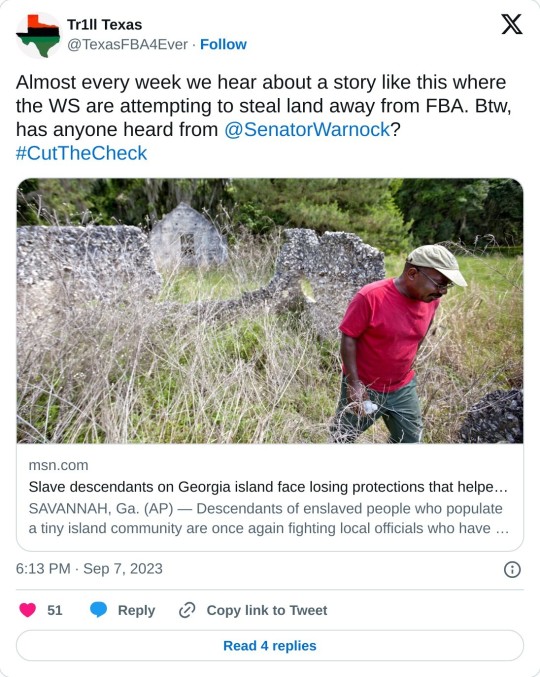
DARIEN, Ga. — Descendants of enslaved people who populate a tiny island community are once again fighting their local government, this time over a proposal to eliminate protections that for decades helped shield the Gullah-Geechee residents from high taxes and pressure to sell their land to developers.
Residents of Hogg Hummock and their supporters packed a courtroom Thursday night to oppose a proposal by McIntosh County officials to cast aside zoning ordinances that limit homes to modest sizes in the enclave of 30 to 50 Black residents on Sapelo Island off the coast of Georgia.
After more than 30 people spoke out against the proposal over two hours, the county zoning board made some hasty changes aimed at appeasing island residents and then voted to send the amended ordinance to McIntosh County's elected commissioners. The five-member commission has the final say, and could choose to vote on the original zoning proposal that rattled island residents when it meets next week.
The rules were enacted in 1994 for the sole purpose of protecting one of the South's few remaining communities of people known as Gullah, or Geechee in Georgia, whose ancestors worked island slave plantations. Their isolation from the mainland meant they retained much of their African roots and traditions.
Residents say losing zoning protections would drive out Hogg Hummock residents by attracting wealthy transplants eager to build large beach houses, causing land values and property taxes to soar.
“It’s the erasure of a historical culture that’s still intact after 230 years," said Reginal Hall, a Hogg Hummock landowner whose family has deep roots on the island. "Once you raise those limits and the land value increases, we only have two to three years at most. If you talk about the descendants of the enslaved, 90% of us will be gone.”
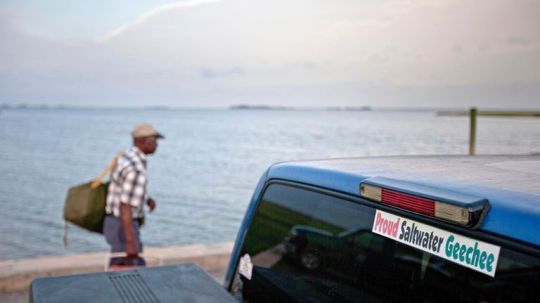
A sticker celebrating the Geechee heritage is seen on a pickup truck, June 10, 2013, as passengers board a ferry to the mainland from Sapelo Island, Ga. One of the few remaining Gullah-Geechee communities in the U.S. is in another fight to hold onto land owned by residents' families since their ancestors were freed from slavery. The few dozen remaining residents of the tiny Hogg Hummock community on Georgia's Sapelo Island were stunned when they learned county officials may end zoning protections enacted nearly 30 years ago to protect the enclave from wealthy buyers and tax increases. Credit: AP/David Goldman
Gullah-Geechee communities are scattered along the Southeast coast from North Carolina to Florida, where they have endured since their enslaved ancestors were freed by the Civil War. Scholars say these people long separated from the mainland retained much of their African heritage — from their unique dialect to skills and crafts such as cast-net fishing and weaving baskets.
Hogg Hummock earned a place in 1996 on the National Register of Historic Places, the official list of America's treasured historic sites. But for protections to preserve the community, residents depend on the local government in McIntosh County, where 65% of the 11,100 residents are white.
The current ordinance designating a special zoning district for Hogg Hummock limits homes to 1,400 square feet (130 square meters) of heated and air-conditioned space, prohibits paving except for building foundations and requires a permit to demolish any structure deemed eligible for the National Register.
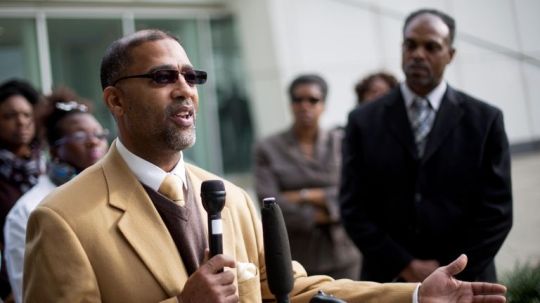
Sapelo Island, Ga., descendant and land owner Reginald Hall speaks at a news conference outside federal court, Dec. 9, 2015, in Atlanta. One of the few remaining Gullah-Geechee communities in the U.S. is in another fight to hold onto land owned by residents' families since their ancestors were freed from slavery. The few dozen remaining residents of the tiny Hogg Hummock community on Georgia's Sapelo Island were stunned when they learned county officials may end zoning protections enacted nearly 30 years ago to protect the enclave from wealthy buyers and tax increases. Credit: AP/David Goldman
County attorney Adam Poppell said the square-footage limit had proven impossible to enforce. The zoning board hoped to satisfy Hogg Hummock residents' concerns about supersized homes by voting to limit development to no more than 10% of a lot, as opposed to 40% in the existing zoning ordinance.
Hogg Hummock resident Jazz Watts said he felt the changes were rushed and that the zoning board should have thrown out the entire proposal.
“They need to start over,” Watts said. “There are too many questions that they can't even answer.”
Patrick Zoucks, the county manager, defended the zoning proposal in a statement issued before the Thursday meeting, saying it was“in the best interest of the residents of Hogg Hammock and all of the citizens of McIntosh County. ”
“Nothing about this issue involves race, or the discriminatory application of the regulations,” Zoucks said.
Commissioner Roger Lotson, whose district includes Sapelo Island, opposed the original proposal to eliminate the maximum home size in Hogg Hummock. He said the zoning board's changes, while welcome, seemed rushed. And he noted the county commission could reject them altogether and vote on the original plan.
“All they're doing is giving us a recommendation,” Lotson said.
It's not the first time Black residents of Sapelo Island have battled with the county government.
Some families have sold to outsiders who built vacation homes. In 2012, dozens of Hogg Hummock residents and landowners swarmed the county courthouse to appeal painful tax increases caused by soaring property values. County officials rolled most of them back.
Residents then sued the county in federal court in 2015, arguing a lack of government services such as firefighters and trash collection were eroding the island community. The case was settled last year, with McIntosh County agreeing to improve emergency services and road maintenance. Some residents also had their property taxes frozen through 2025.
Lotson said he's unsure how his fellow commissioners will vote, though he's trying to persuade them that Hogg Hummock is worth preserving.
“It’s a step back in time," Lotson said. "And the fear of many, including myself, is that by allowing any size house over there, soon the uniqueness of Sapelo will go away.”
#Slave descendants on Georgia island fighting to keep protections that helped them keep their land#georgia sea islands#Freedmen#FBA#Black Farmers#Black Ancestral Homesteads#Black Land in america#Sapelo Island
36 notes
·
View notes
Text
https://x.com/Phil_Lewis_/status/1703407420515442919?t=KZA9wU6ZOvHpoTyQobuXKQ&s=09

For over 230 years, Gullah-Geechee people called Georgia's Sapelo Island home County commissioners voted to remove zoning restrictions & to strike language stating it should prevent “land value increases which could force removal of the indigenous" folk
For more than 230 years, a small community of Gullah-Geechee people have called Sapelo Island off the coast of Georgia home. Hogg Hammock, the area on the island where these descendants of enslaved people live, is a 427-acre coastal community of 40 residents and has been designated as a historic site since 1996. That means that the construction of houses more than 1,400 sq ft and any road paving or demolition of property are strictly prohibited to preserve the island community.
On Tuesday, McIntosh county commissioners, who preside over Sapelo, voted to remove zoning restrictions in Hogg Hammock. Gullah-Geechee residents fear that wealthy transplants who want to develop larger homes and who could force a rise of property taxes there will displace them and upend their livelihoods.
The county, which is 65% white, has voted to remove official language that acknowledges Hogg Hammock as an area with “unique needs in regard to its historic resources”. It will also strike language that states it should prevent “land value increases which could force removal of the indigenous population”.

Last Thursday, dozens of residents gave hours of testimony to the county’s zoning board arguing against the proposed changes, warning that the county had hastily made changes without community consideration. Reginald Hall, a landowner whose family had roots in Hogg Hummock, told the Associated Press the county’s approval would amount to “the erasure of a historical culture that’s still intact after 230 years”.
Residents and state lawmakers called for the county to delay their vote and to reflect on proposed changes for 90 days. “We will not allow our cultural history to be erased or bought at the price of land developers,” the state representative Kim Schofield, who represents Atlanta, told reporters. “This is our history and our heritage, and we will fight to protect it.”
Hall warned the county’s vote to remove development limits would give Gullah -Geechee residents in Hogg Hammock just “two to three years at most” to survive in the county before they scatter elsewhere, as 200,000 Gullah-Geechee people have already done across the south-eastern corridor of the United States. “If you talk about the descendants of the enslaved,” she said, “90% of us will be gone.”
16 notes
·
View notes
Text
The McIntosh County Commission passed a controversial zoning ordinance amendment Tuesday that residents of the last remaining Geechee community in Georgia say could push them out of the ancestral home.
The amendment changed a nearly 30-year-old rule that limited the size of dwellings in the Hogg Hummock, also called Hog Hammock, community to 1,400 square feet of heated and cooled space to allow homes as large as 3,000 square feet of enclosed, interior space. The existing ordinance was unenforceable, commissioners said, because people would leave unfinished space to get a certificate of occupancy and then go back and finish off a house to make it larger than the ordinance allowed.
Commissioner Roger Lotson, who represents Sapelo Island on the county commission, spoke for the vocal opposition at the meeting and said allowing houses that large in the community once owned exclusively by descendants of formerly enslaved people will lead to higher property values and higher property taxes and push people out of their ancestral homes. That will ruin the cultural and historic uniqueness of the community, he said.
“Mostly, we need to do what we said we would do,” Lotson said, referring to a comprehensive plan for the county that includes preserving history and cultural heritage. “We talked the talk, now it’s time to walk the walk.”
Opponents have said they were not included in the process of writing the ordinance amendment and that they were not given enough time to make their feelings known about it. A public hearing was held Thursday at which dozens of people spoke in opposition to the amendment, saying that it would lead to the erasure of the Geechee community on Sapelo Island and destroy a long and proud heritage.
Lotson said he had not spoken to one person who was in favor of the new zoning rules.
He implored his fellow commissioners to vote against passing the amendment and made a motion to bring down the maximum square footage further, to 2,180 square feet. That motion failed.
Commissioner Davis Poole then made a motion to pass the amendment with the 3,000-square-foot rule in place. Commissioner Katie Karwacki seconded the motion. She and Poole voted for the amendment to pass. Lotson and Commissioner William Harrell voted against it. Commission Chairman David Stevens cast the tie breaking vote.
Poole said after the motion passed that he took an oath to treat everyone equally as a county commissioner and that this amendment was a reasonable compromise. It will prevent mansions being built in Hogg Hummock while also allowing for larger homes than currently exist.
“This change will not destroy the culture of Gullah-Geechee on the island,” he said. “… We need to work together to move forward to collaborate on ways to economically empower the island residents.”
Stevens refuted claims by people who said they did not have enough time to provide input on the amendment. He said groups had sought input for more than a year with the purpose of influencing the amendment’s final version.
He also refuted the claim that the new rule is a money grab for property taxes or to allow wealthy people to take over the historically Black community.
“It was never my personal attempt or intent to allow 15,000 or 20,000 square foot homes to be built on Sapelo Island,” Stevens said. “I would not have supported it if that was the case.”
Stevens and Poole both noted that all the property in Hogg Hummock was once owned only by Geechee descendants who now have sold off roughly 50 percent of the lots. The best way to stop unwanted new homes or outsiders into the community is to stop selling the land, Stevens said.
He named numerous prominent people from Sapelo Island who he has known and said the island is special to him as it is to many others.
Josiah “Jazz” Watts, a justice strategist for the environmental group 100 Miles, said 3,000 square feet is too large and will ruin the historic character of Hogg Hummock.
It will also threaten the natural and ecological beauty and uniqueness of the island.
“We’re here now because the county failed to do its job,” Watts said of enforcing the 1,400-square-foot rule.
He said simply removing the heated-and-cooled square footage language would have made the ordinance enforceable.
“That’s like saying the speed limit is 50, but people go 75, so we’ll make the speed limit 100,” Watts said.
He said the community will mobilize and look at all legal options moving forward.
“We’re going to fight this,” Watts said
#Controversial Sapelo zoning ordinance passes#Gullah#Gullah Geechee Land#Sapelo Island#Geechee Land#white lies#white interlopers
0 notes